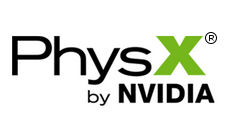NVIDIA PhysX SDK 4.0 Documentation¶

Built December 21, 2018
Contents:
- User's Guide
- PhysX License
- Welcome to PhysX
- Snippets
- Building with PhysX
- The PhysX API
- Startup and Shutdown
- Threading
- Geometry
- Rigid Body Overview
- Rigid Body Collision
- Introduction
- Shapes
- Simulation Shapes and Scene Query Shapes
- Kinematic Triangle Meshes (Planes, Heighfields)
- Broad-phase Algorithms
- Regions of Interest
- Broad-phase Callback
- Collision Filtering
- Aggregates
- Creating an Aggregate
- Populating an Aggregate
- Releasing an Aggregate
- Amortizing Insertion
- Trigger Shapes
- Interactions
- Rigid Body Dynamics
- Simulation
- Advanced Collision Detection
- Joints
- Articulations
- Maximal Coordinate and Reduced Articulations
- Maximal Coordinate Articulations
- Reduced Coordinate Articulations
- Scene Origin
- GPU Rigid Bodies
- Geometry Queries
- Scene Queries
- Vehicles
- Character Controllers
- Introduction
- Kinematic Character Controller
- Creating a character controller
- Overlap Recovery Module
- Character Volume
- Volume Update
- Moving a Character Controller
- Graphics Update
- Auto Stepping
- Climbing Mode
- Up Vector
- Walkable Parts & Invisible Walls
- Obstacle Objects
- Hit Callback
- Behavior Callback
- Character Interactions: CCT-vs-dynamic actors
- Character Interactions: CCT-vs-CCT
- Hidden Kinematic Actors
- Time Stepping
- Invalidating Internal Geometry Caches
- Runtime Tessellation
- Troubleshooting
- Debug Visualization
- PhysX Visual Debugger (PVD)
- Simulation Statistics
- Serialization
- Extending Serialization
- Best Practices Guide
- Migrating From PhysX SDK 2.x to 3.x
- Migrating From PhysX SDK 3.2 to 3.3
- Migrating From PhysX SDK 3.3 to 3.4
- Migrating From PhysX SDK 3.4 to 4.0